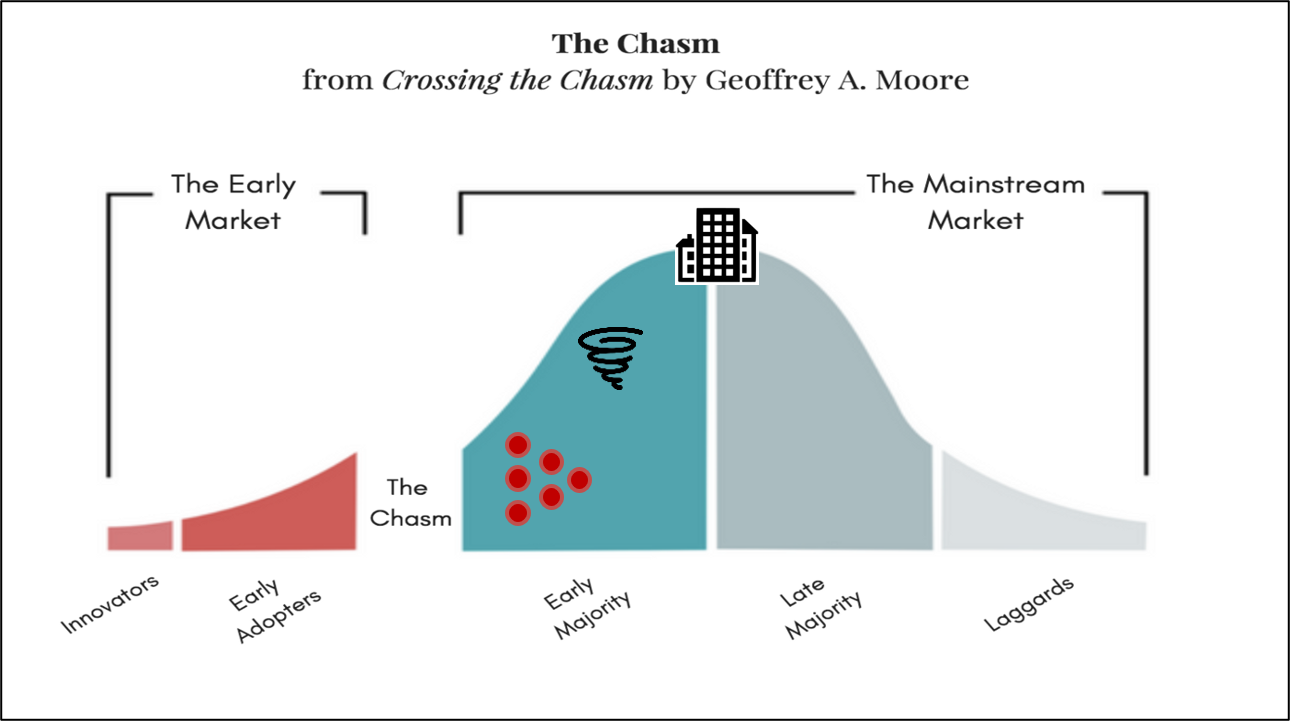 Selling in emerging markets is very different than selling in mainstream markets. In fact, most of what you believe about sales and marketing just doesn’t apply in emerging markets. In this post, we, explore what you need to do and why.
Selling in emerging markets is very different than selling in mainstream markets. In fact, most of what you believe about sales and marketing just doesn’t apply in emerging markets. In this post, we, explore what you need to do and why.
How Tech Markets Develop
Having a framework is helpful to understand what happens in an emerging market and allows you to clearly understand how to develop your marketing programs to be the most effective.
There is a well-known and accepted framework developed by Geoffry Moore introduced in his book Crossing the Chasm. Considered The bible for bringing cutting-edge products to market, it focuses on the challenges start-up companies face transitioning from early adoption to mainstream customers. It has sold more than a million copies and is in its third edition.
Moore shows that in the Technology Adoption Life Cycle—which begins with innovators and moves to early adopters, early majority, late majority, and laggards—there is a vast chasm between the early adopters and the early majority. While early adopters are willing to sacrifice for the advantage of being first, the early majority waits until they know that the technology actually offers improvements in productivity. The challenge for innovators and marketers is to narrow this chasm and ultimately accelerate adoption across every segment.
In the figure below, you can easily see that there is a clear distinction between the early market and the mainstream market. The differences in the markets dictate how you market and sell in these markets.

Once a technology or product has crossed the chasm, there are three milestones that need to be recognized; the Bowling Alley, the Tornado, and Main Street. A major shift happens at each milestone.
- Bowling alley - The main idea of the bowling alley is that when you go to cross the chasm there is a shift from a partial product to a whole product, Visionaries will accept an incomplete product, a technology, while Pragmatists will only accept a complete product. This is when sales efforts shift from the Technology User to the Economic Buyer.
- Tornado – This is when the current market leader is propelled into hypergrowth, into the Tornado, by the sudden rush of pragmatist buyers who choose a vendor to become the de-facto standard. There is one clear winner emerging from the tornado.
- Main Street – Once the market a reached the Main Street milestone, products are commoditized.
Characteristics of the Early Market Adopters
The persona characteristics of innovators and early adopters are the following:
- Intuitive and visionary. They see themselves as smarter than their peers.
- Contrarian – Early adopters are happy to challenge the status quo.
- Take risks – Early adopters are not "rule followers." They believe it is easier to ask for forgiveness than ask for permission.
- Motivated by future opportunities and securing a competitive advantage.
- Early adopters are technologists, line of business visionaries, or strategists.
Characteristics of Pragmatists in Main Street Markets
The persona characteristics of pragmatists, the main buying persona, in early majority markets are the following.
- Require analytic support – Pragmatists require data before they make a decision
- Evolution conformist – Pragmatists understand that the business needs to evolve but will not lead the evolution.
- Consult with their colleagues – Peer review is critical to their decisions.
- Motivated by present problems – Pragmatists are trying to solve an existing problem that is well understood.
- Pragmatists are typically business people
Tipping Points Along the Journey
In an early adopter market, buyers are not solving a well-defined problem. Buyers are looking at how they can leverage technology or something brand new to gain a competitive advantage.
In this type of market, you will need to market and sell a vision, with a clearly defined path on how to achieve that vision. You may be selling technology or a piece of a solution that is only one part of the overall solution. Sales tend to focus on business development and partnership activities. There is a steep education curve in early markets and marketers need to develop educational content. Advertising rarely yields great results in early markets however brand building activities such as public relations, social media, conferences, and content marketing are the pillars of successful programs.
Once the early adopters gain a competitive advantage, the pragmatists will begin to understand that they have a problem because they begin to fall behind the market leaders and they realize they can’t compete with what they are doing today. This is when vendors need to transition into a solutions sale and customers will be looking for a whole product solution. Marketers need to focus on ROI, case studies, solutions brochures, etc. This is when adding advertising and lead nurturing yields good results.
Red Javelin is an expert in early markets as well as early majority markets. If you need help, sign up for a free consultation. No pressure. No obligation - just a conversation.




